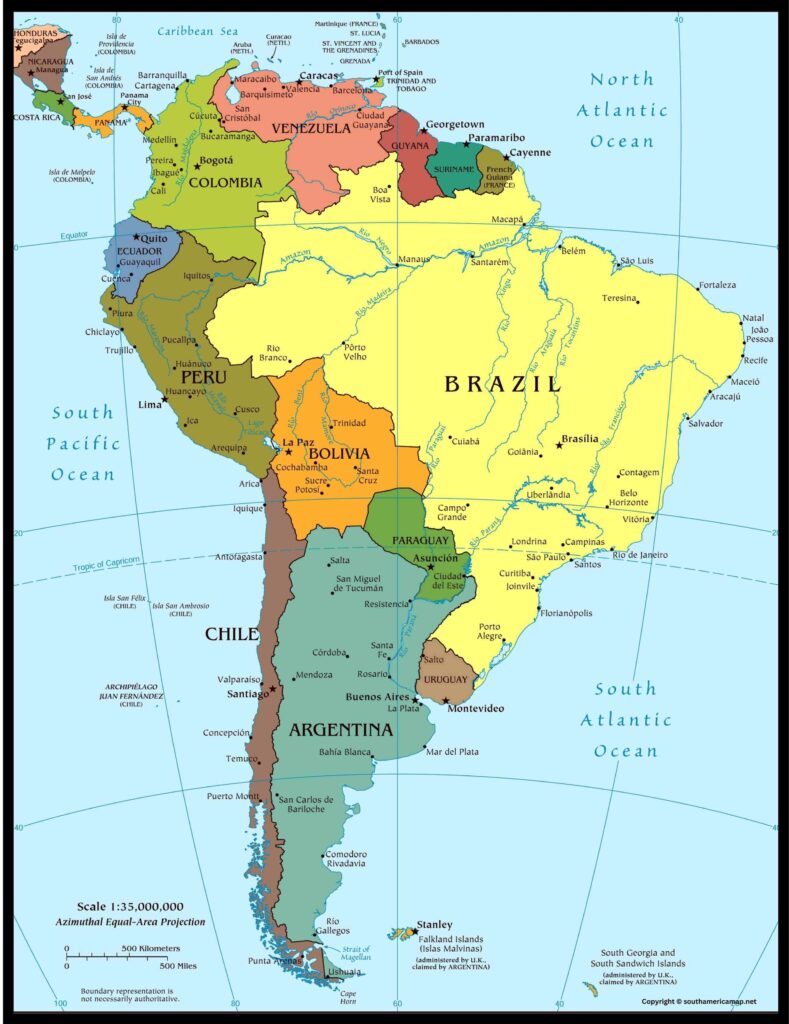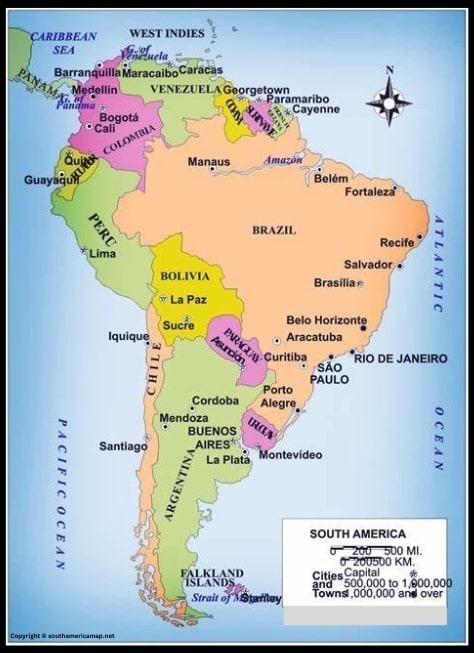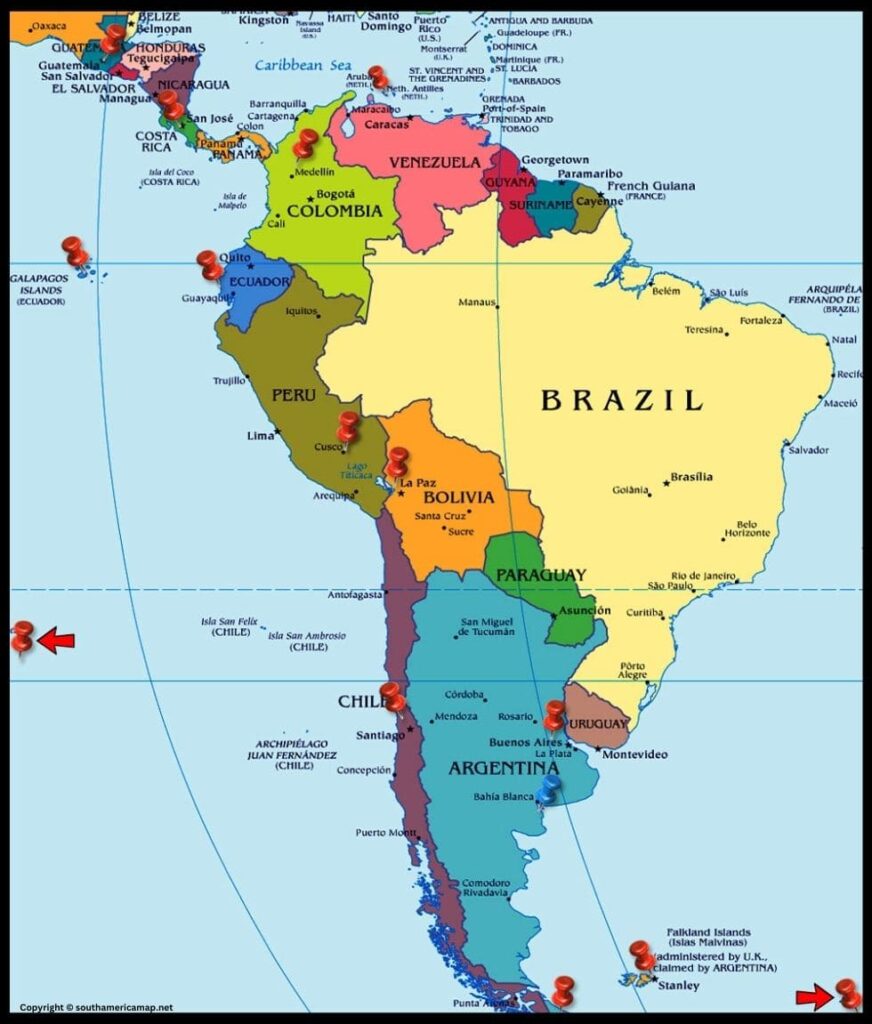A South America political map holds significant value in understanding the continent’s political landscape and its implications. It provides a visual representation of national borders, capitals, major cities, administrative divisions, and other political entities, offering various benefits for different purposes.
Related Post –
South America Political Map
- Understanding political geography: A political map allows students and individuals to visualize the political boundaries of South American countries, their relative sizes and locations, and their capitals. This information fosters a deeper understanding of the continent’s political structure.
- Exploring political history: By studying political maps, individuals can learn about historical events such as colonial expansion, border disputes, and territorial changes. This knowledge provides context for understanding current political dynamics within South America.
- Analyzing political trends: Political maps can be used to analyze political trends and developments across the continent. For example, students can study the distribution of political parties, voting patterns, and areas of political unrest.
- Navigation and orientation: A political map helps travelers navigate unfamiliar regions, locate points of interest within specific countries, and understand the political context of the places they visit.
- Crossing international borders: By understanding border crossings between countries, travelers can plan their itineraries efficiently and be aware of any visa requirements or restrictions.
- Understanding local laws and customs: A political map can provide context for understanding local laws and customs within different countries in South America, promoting respectful behavior and cultural awareness.
Political Map for South America with Countries
- Market analysis and expansion: Businesses can use political maps to identify potential markets within specific countries, analyze competitor locations, and plan their expansion strategies efficiently.
- Understanding legal and regulatory frameworks: By studying political boundaries and administrative divisions, businesses can gain insights into the legal and regulatory frameworks of different regions, ensuring compliance with local laws.
- Facilitating trade and economic cooperation: Political maps assist businesses in understanding trade agreements, economic partnerships, and regional trade blocs within South America, promoting collaboration and economic opportunities.
- Promoting political participation: Political maps can be used to educate citizens about their electoral districts, voting rights, and political representatives. This information empowers individuals to participate actively in the political process.
- Monitoring political developments: By studying political maps and changes in political boundaries, individuals can stay informed about current political events and developments across the continent.
- Understanding international relations: Political maps help individuals visualize international relations between South American countries, including alliances, diplomatic ties, and potential areas of conflict.
Central And South America Political Map
South America is a continent known for its vibrant cultural diversity, rich history, and diverse landscapes. Comprising twelve countries, each with its unique characteristics, the continent holds significant political and geographical importance.
The largest country in South America, Brazil, is not only known for its vast Amazon Rainforest but also for its bustling cities, including the capital Brasília. Argentina, another prominent nation, boasts a mix of European and Latin American influences and is recognized for its cultural contributions, particularly in music and dance.
Chile, stretching along the Pacific coast, is characterized by its stunning natural scenery, including the Andes Mountains and the Atacama Desert. Colombia, nestled between the Caribbean Sea and the Pacific Ocean, has made strides in recent years to overcome historical challenges and has become a destination known for its warmth and hospitality.
Venezuela, endowed with significant oil reserves, has faced political and economic challenges in recent times, impacting both its citizens and the global energy landscape.
Peru, home to the iconic Machu Picchu and a diverse range of ecosystems, has a rich cultural heritage dating back to ancient civilizations. Ecuador, straddling the equator, is known for its biodiversity and the unique Galápagos Islands.
Bolivia, a landlocked nation, features the high-altitude capital La Paz and the constitutional capital Sucre, offering a blend of indigenous and colonial influences. Paraguay, situated in the heart of South America, is known for its Guarani culture and the Paraguay River.
Smaller nations like Uruguay, with its progressive social policies and beautiful beaches, and Guyana, an English-speaking country with a mix of Caribbean and South American influences, contribute to the overall tapestry of South America.
Suriname, known for its multicultural population, and French Guiana, an overseas department of France, add further layers to the region’s diversity. These political entities, each with its unique challenges and opportunities, collectively form the dynamic and complex political landscape of South America.


